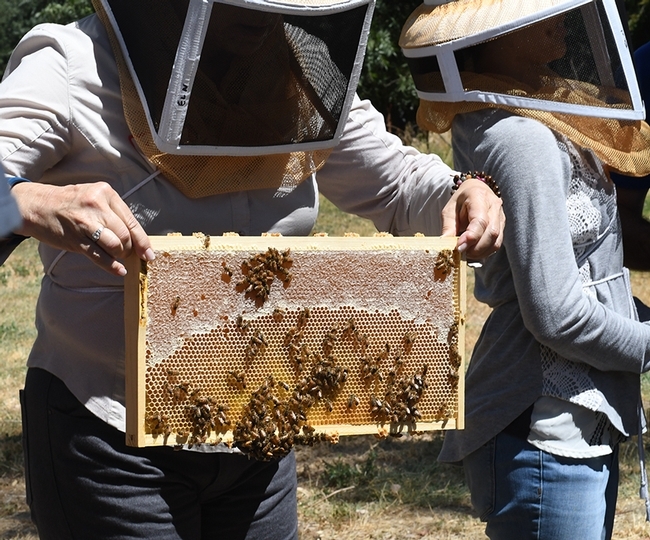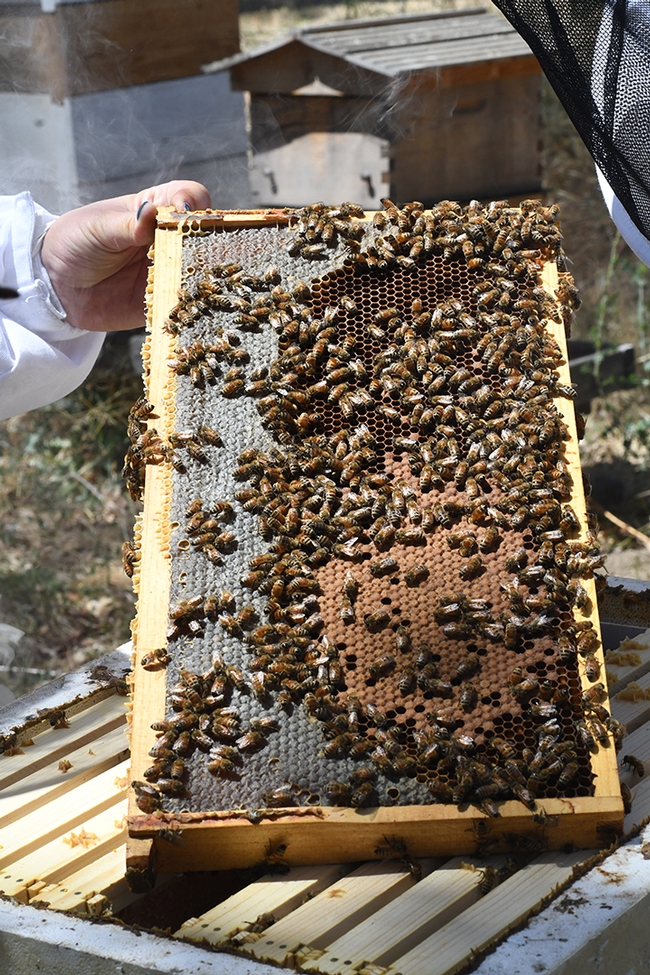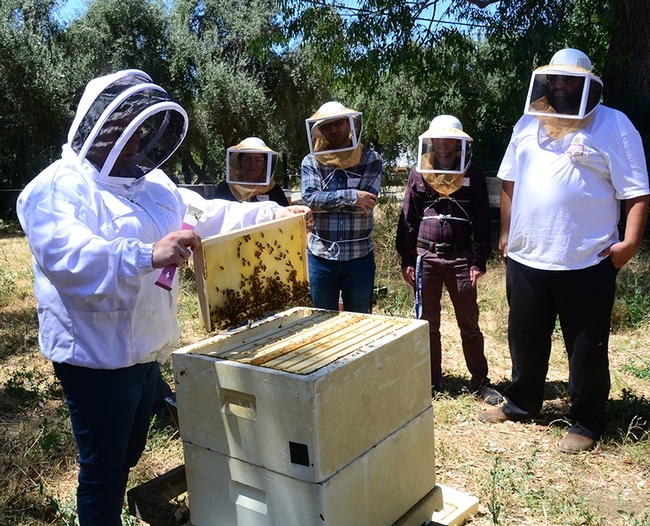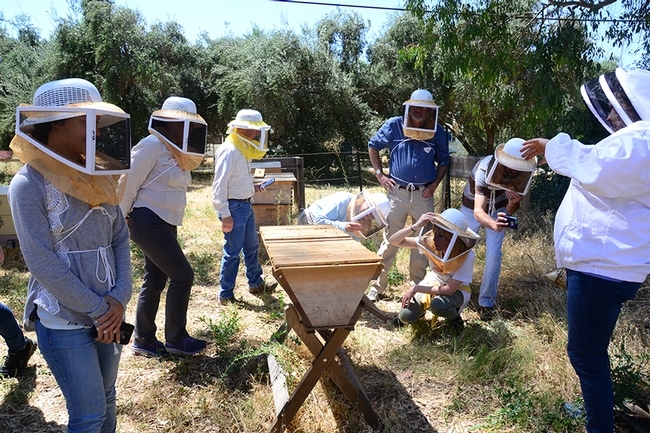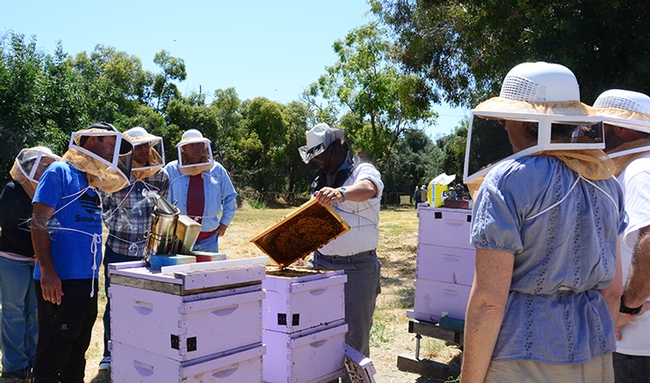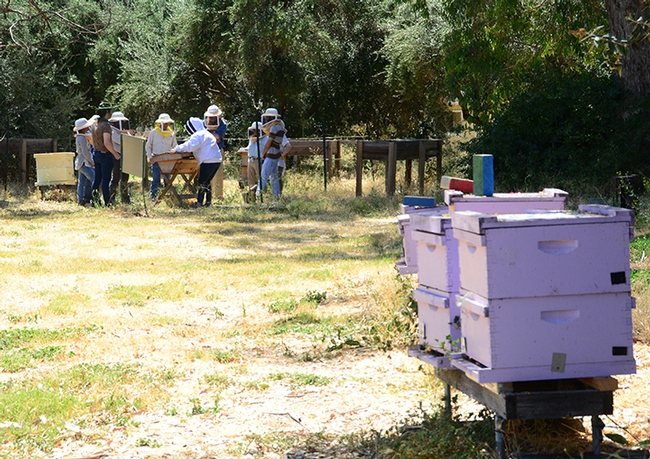- Author: Kathy Keatley Garvey
It's Labor Day but "The Girls" continue to work.
"The Girls" are the honey bees, a great example of a matriarchal society. How many workers (girls) do you see foraging on your flowers? But inside the hive, "The Girls" are nurse maids, nannies, royal attendants, builders, architects, dancers, honey tenders, pollen packers, propolis or "glue" specialists, air conditioning and heating technicians, guards, and undertakers. And the males? Their responsibility is to mate with a virgin queen--and then they die.
In his newly published book, Honey Bee Biology (2023 Princeton University), UC Davis bee scientist Brian Johnson of the Department of Entomology and Nematology, covers everything from molecular genetics, development, and physiology to neurobiology, behavior, and pollination biology. It's meant for bee scientists, social insect biologists, beekeepers, and those who are just eager to learn more about honey bees.
Honey bees "evolved from the hunting wasp, a group of four clades of wasps that typically provision their offspring with insects or spiders," Johnson writes in his opening chapter, 'Natural History, Systematics and Phylogenetics.' Probably the most well known of the hunting wasps (to the nonentomologist) are the mud daubers that build their nests on the sides of people's homes."
"The split between these wasps and what evolved into the bees occurred about 120 million years ago," Johnson writes.
Basically, wasps continue to be meat-eaters, but honey bees "have gone vegetarian," as Johnson points out.
When you see honey bees foraging on flowers, gathering nectar and pollen, just remember that they are vegetarians. And especially, on Labor Day, remember how "The Girls" tend to the needs of the queen, their sisters and their brothers.
As a society, we could learn a lot from honey bees.

- Author: Kathy Keatley Garvey
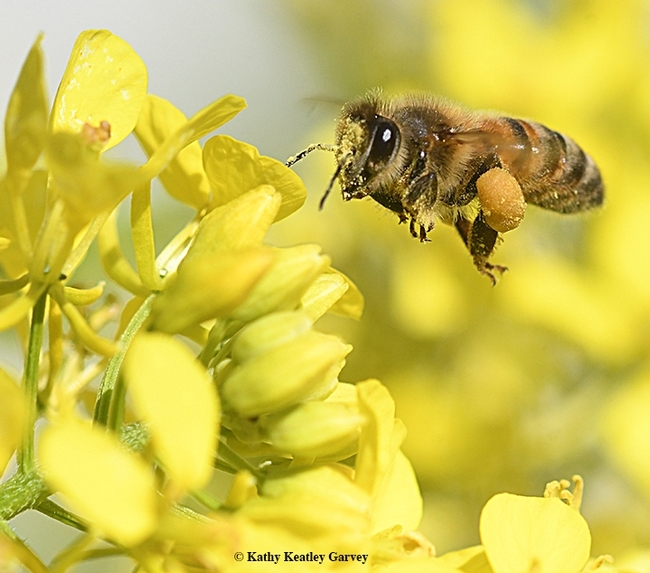
National Honey Bee Day is Saturday, Aug. 19 and you're invited to join this oh-so-sweet celebration!
Launched in 2009, National Honey Bee Day takes place on the third Saturday of August. The event originated when a small group of beekeepers petitioned the U.S. Department of Agriculture "to honor" the honey bees and beekeepers.
HoneyLove.org, a Los Angeles-based honey bee educational non-profit organization, manages National Honey Bee Day and boosts "the educational outreach, community action and advocacy efforts to protect the health and well-being of honey bees," according to its website.
California Master Beekeeper Program. While we're honoring bees, we should also honor the UC Davis-based California Master Beekeeper Program (CAMBP), founded and directed by Elina Lastro Niño,associate professor of Cooperative Extension and a member of the faculty of the UC Davis Department of Entomology and Nematology.
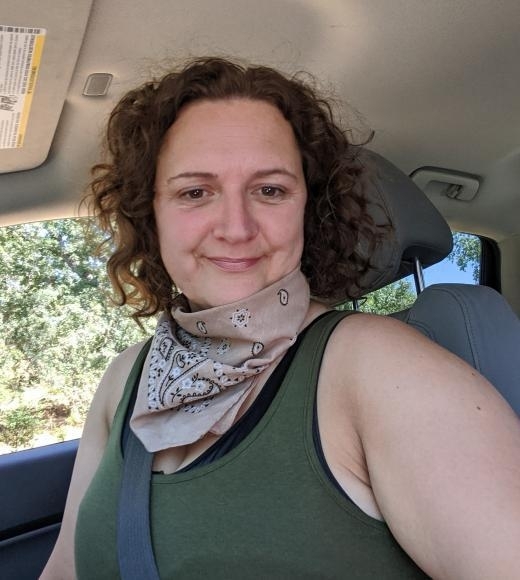
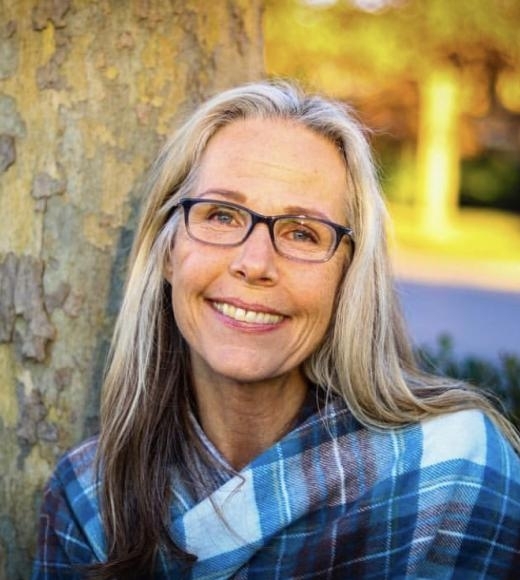
"The award seeks to highlight teams who actively develop and encourage faculty/staff partnerships and as a result are able to make notable contributions to UC Davis that contribute to the University's Mission of Teaching, Research, and Service; and who exemplify outstanding achievement and/or service," according to Staff Assembly officials.
At the time of the nomination (March 15, 2023), CAMBP had
- Given 32,000 hours of volunteer time (Beneficial Educational Experiences) and served 186,630 individuals in education, outreach and beekeeping mentorship. If a volunteer hour is worth $26.87, the program has given $859,840 back to the state of California in service of science-based beekeeping and honey bee health.
- Enrolled 185 Honey Bee Ambassadors (a level established in 2021), 494 Apprentice, 93 Journey level candidates and certified 20 Master level beekeepers. There are 12 members in 2023 participating in their Master Capstone projects.
- Recorded 3752 hours since the team began tracking Continuing Education Experiences in 2020.
- Embarked on a project updating a safety manual.
National Honey Bee Day is also a good opportunity to learn about bees, our mini-agricultural workers that pollinate one-third of the food we eat.
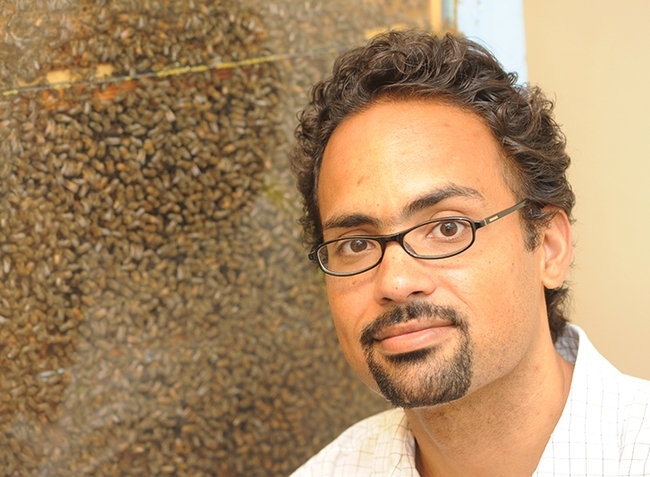
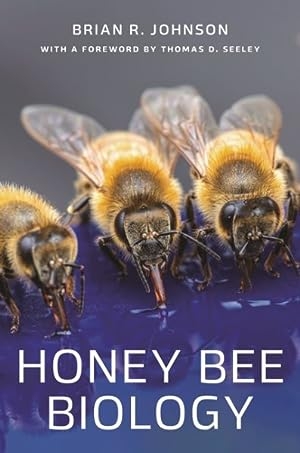
The book includes 16 color plates (images contributed by Kathy Keatley Garvey), spotlighting a bee egg, bee castes, swarms and almond pollination, among others.
Princeton University Press bills the book as "the first up-to-date general reference of its kind published in decades. It is a must-have resource for social insect biologists, scientifically savvy beekeepers, and any scientist interested in bees as a model system."
Among his many honors and recognitions, Johnson was part of The UC Davis Bee Team that won the 2012 Team Award from the Pacific Branch, Entomological Society of America. Other members: Extension apiculturist Eric Mussen (1944-2022); systematist/hymenopterist Lynn Kimsey, director of the Bohart Museum of Entomology and professor of entomology; native pollinator specialist Robbin Thorp (1933-2019) emeritus professor of entomology; and pollination ecologist Neal Williams (now professor) who specializes in pollination and bee biology.
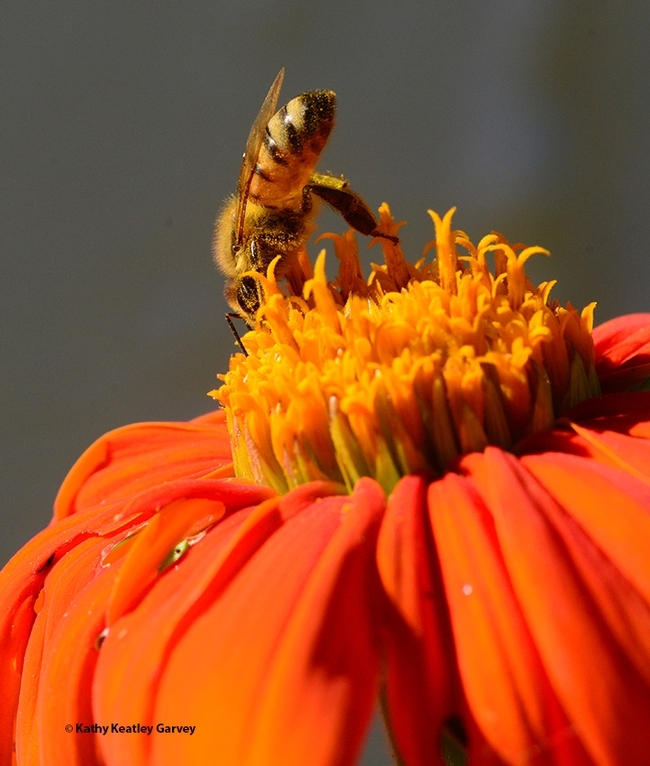
- Author: Kathy Keatley Garvey
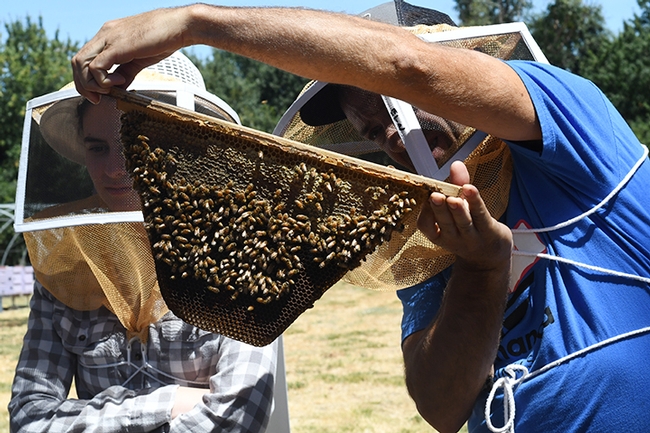
Extension apiculturist Elina Lastro Niño of the UC Davis Department of Entomology and Nematology faculty and director of the UC Davis-based California Master Beekeeper Program (CAMPB) teaches classes with her lab associates throughout much of the year.
Participants agree that the classes are "the bees' knees," a phrase which means they're excellent, of the highest quality.
One of the most recent classes, "Planning Ahead for Your First Hives," drew the maximum of 23 participants at the Harry H. Laidlaw Jr. Honey Bee Research Facility on Bee Biology Road.
The group spent a Saturday learning all about honey bees via lectures and hands-on activities.They learned bee biology, components of the hive, where to place the hive, and how to plan for their first hive--all under the tutelage and watchful eyes of the two Niños: Elina Lastro Niño and husband/beekeeper Bernardo Niño, who is the CAMPB educational program supervisor and a staff research assistant in the E. L. Niño lab.
Then the participants donned bee veils and stepped outside to the apiary to learn hive inspection basics. They returned to the classroom for lunch and a Powerpoint presentation on "Keeping Bees Year-Around."
Highlights included opening a hive and engaging in queen wrangling, hands-on activities (holding a frame and identifying the queen, worker bees and drones), and varroa mite monitoring. The participants also examined several different types of the hives in the apiary, including the traditional Langstroth hive, Kenya top bar hive or horizontal top bar-hive, Warré hive and a flow hive. The short course ended with a session on "Save us from the hive intruders!" and a question-and-answer period.
The next day CAMPB hosted another short course, this one on "Working Your Colonies." Participants learned what is necessary to maintain a healthy colony. Lectures covered advanced honey bee biology, honey bee integrated pest management, and products of the hive. The group also learned about queen wrangling, honey extraction, splitting/combined colonies, and monitoring for varroa mites.
Both courses drew maximum enrollment. "The classes were excellent," commented Wendy Mather, program manager of CAMPB. "We received really great feedback and the participants were thrilled to get the in-hive experience. And we got to sample some melipona honey (from stingless bees) from the Yucatán, as one of our participants had recently returned from a trip there."
The participants "now have some science-based knowledge and skills about honey bees and beekeeping that they can confidently share," Mather said. CAMPB uses science-based information to educate stewards and ambassadors for honey bees and beekeeping.
Next Class: Varroa Mite Management Strategies
The next beekeeping class? "Varroa Mite Management Strategies" from 9 a.m. to 4 p.m., Sunday, Oct. 13 at the Laidlaw facility. Participants will learn how to monitor, mitigate and manage the pests.
"Current beekeeping challenges call for all beekeepers to have a solid understanding of varroa mite biology and management approaches," said Elina Lastro Niño, in describing the course. "We will dive deeper into understanding varroa biology and will devote majority of the time to discussing pros and cons of various means to monitor, mitigate, and manage this crucial honey bee pest."
Niño, who serves as the state's Extension apiculturst, is known for her expertise on honey bee queen biology, chemical ecology, and genomics. She holds a doctorate in entomology from Pennsylvania State University (PSU), where she served as a postdoctoral fellow in the lab of Christina Grozinger, director of the PSU Center for Pollinator Research.
The course, limited to 20 participants, will cover varroa biology, treatment options and chemical-free options. Participants are to bring their bee veil or suit. The $200 registration fee covers the cost of course materials, lunch and refreshments. The last day to register is Monday, Oct. 7. Click here to register.
The eight-legged varroa mite (Varroa destructor) is an external parasite that attacks and feeds on honey bees. The female is reddish brown, while the male is white. They measure 1–1.8 mm long and 1.5–2 mm wide. Originating in Asia, varroa mites are now found throughout most of the world. Scientists first detected the pest in the United States in 1987.
For more information on the varroa mite course or other CAMPB courses, access the website or contact Mather at wmather@ucdavis.edu.
